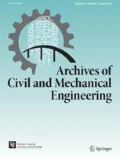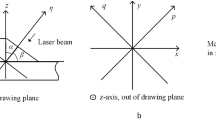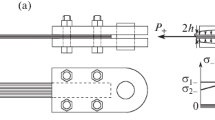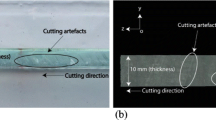Abstract
The paper describes the results obtained from the tensile and compression experimental tests of the structural tempered glass plates with three different types of stress concentrators and without them. The types of stress concentrator have been chosen as close as possible to those usually found in practical situations and also taking into account the cases known from the literature. All tests are performed under the same conditions and with the step of loading 1.0 kN for tension and compression tests up to the limit of 8.0 kN. The stress gradients are measured with an optical device by birefringence. The research is aimed at determining the distribution and the values of stress gradients under tension and compression. The paper considers the problems of determining the stress values and their distribution in the glass plates with various stress concentrators, based on the results of non-destructive measuring, analytical calculations and the numerical simulation.

























Similar content being viewed by others
References
Eliasova V. Bolted connections of glass structures by means of two holes in-line. In: Proceedings of the conference on architectural and structural applications of glass (challenging glass). Delft, The Netherlands. 2008. p. 279–284.
EN 15682-1. Glass in building-Heat soaked thermally toughened alkaline earth silicate safety glass - Part 1: definition and description. 2013.
Feldmann M, Kasper R. Guidance for European structural design of glass components (Issue February 2016).2014. https://doi.org/10.2788/5523.
Hagl A. Bonded point-supports: understanding today—optimizing for the future. In: Proceedings of the conference on architectural and structural applications of glass (challenging glass 2). Delft, the Netherlands. 2010. p.259–268.
ISO 11455:1995 Raw optical glass–determination of birefringence.
Katsivalis I, Thomsen OT, Feih S, Achintha M. Strength evaluation and failure prediction of bolted and adhesive glass/steel joints. Glass Struct Eng. 2018;3(2):183–96. https://doi.org/10.1007/s40940-018-0070-0.
Katte H. Bildgebende Messung der Spannungsdoppelbrechung in optischen Materialien und Komponenten. Photonik, Band, Heft 5, S. 2008. p. 60–63.
Kooymans J. Long span glass fin design. In: Proceedings of the conference on architectural and structural applications of glass (challenging glass). Delft, the Netherlands. 2008. p.89–99.
Matusita K, Yokota R, Kimijima T, Komatsu T, Ihara C. Compositional trends in photoelastic constants of borate glasses. J Am Ceram Soc. 1984;67:261–5.
McDonnell TR, Thompson D. Structural glass observation boxes (Willis Tower ledge). In: Proceedings of the conference on architectural and structural applications of glass (challenging glass 2). Delft, The Netherlands. 2010. p. 129–137.
Nielsen JH, Olesen JF, Stang H.Experimental investigation of residual stresses in toughened glass. In: Proceedings of the conference on architectural and structural applications of glass (challenging glass). Delft, The Netherlands. 2008. p. 387–398.
Nielsen, Jens Henrik. Tempered glass: -bolted connections and related problems. In: Civil Engineering. 2009.
Nielsen JH, Olesen JF, Poulsen PN, Stang H. Simulation of residual stresses at holes in tempered glass: a parametric study. Mater Struct Materiaux et Constr. 2010;43(7):947–61. https://doi.org/10.1617/s11527-009-9558-z.
Pilkey WD. Peterson’s stress concentration factors. Hoboken: Wiley; 1997. p. 524.
Pockels F. Über die Änderung des optischen Verhaltens verschiedener Gläser durch elastische deformation. Ann Phys. 1902;312:745–71.
Pourmoghaddam N, Schneider J. Finite-element analysis of the residual stresses in tempered glass plates with holes or cut-outs. Glass Struct Eng. 2018;3(1):17–37. https://doi.org/10.1007/s40940-018-0055-z.
Reyer E, Walochnik W. 1975. Optische Messverfahren - Anwendung auf tragende Baukonstruktionen. Universitätsbibliothek der technischen Universität Berlin. 104 p.
Šapalas A, Šaučiuvėnas G, Rasiulis K, Griškevičius M, Gečys T. Behaviour of vertical cylindrical tank with local wall imperfections. J Civil Eng Manag. 2019;25(3):287–96. https://doi.org/10.3846/jcem.2019.9629.
Schwiecker, W. 1957. Komponentenabhängigkeit der spannungsoptischen Koeffizienten von Glas. Glastechn Berlin. p 84–88.
Serafinavičius T, Kvedaras AK. Challenges to structural glass: what have been already done. Eng Struct Technol. 2011;3(2):79–89.
Serafinavičius T, Hildebrand J. Šaučiuvėnas, G. Stress distribution of tension structural glass plates. In Proc. Challenging Glass 3: Conference on Architectural and Structural Applications of Glass, 28-29 June 2012, Delft, The Netherlands. p. 565–578.
Serafinavičius T, Kvedaras AK. Review of study on structural glass and structures. In: Proceedings 10th international conference modern building materials, structures and techniques: selected papers, Vol. 2. May 19–21, 2010. Vilnius: Technika. 2010. P. 787–792.
Sonck D, Belis J. Elastic lateral-torsional buckling of glass beams with continuous lateral restraints. Glass Struct Eng. 2016;1(1):173–94. https://doi.org/10.1007/s40940-016-0023-4.
StrainMatic. Reference of the operating software. Erlangen: Ilis gmbh; 2007. p. 45.
Wang Z, Wang Y, Liang Y, Du X, Shi Y. Bearing capacity of tempered glass panel in point supported glass facades against in-plane load. Arch Civil Mech Eng. 2016;16(4):935–48. https://doi.org/10.1016/j.acme.2016.07.005.
Watson J, Nielsen J, Overend M. A critical flaw size approach for predicting the strength of bolted glass connections. Eng Struct. 2013;57:87–99. https://doi.org/10.1016/j.engstruct.2013.07.026.
Author information
Authors and Affiliations
Corresponding author
Rights and permissions
About this article
Cite this article
Šaučiuvėnas, G., Gečys, T., Mudrov, A. et al. The analysis of stress distribution in tempered structural glass with stress concentrators under tension and compression. Archiv.Civ.Mech.Eng 20, 68 (2020). https://doi.org/10.1007/s43452-020-00067-5
Received:
Revised:
Accepted:
Published:
DOI: https://doi.org/10.1007/s43452-020-00067-5




